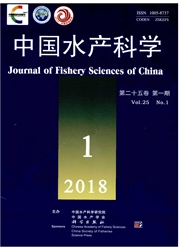

 中文摘要:
中文摘要:
对均重(0.12±0.01)g的中华绒螯蟹(Eriocheir sinensis)仔蟹在6个盐度(0、4、8、12、16、20)梯度下的标准代谢进行研究。各梯度的水温为(24±0.5)℃、溶解氧为(8.12±0.23)g/mL、pH为7.5±0.18。在不同时间段测量各盐度梯度代谢瓶内溶氧量、CO2含量及NH3-N含量,将时间与耗氧率、C02排出率及NH3-N排泄率进行回归分析。研究结果表明,根据仔蟹行为及代谢瓶内氧气含量与时间(h)的回归分析将仔蟹行为可分3个阶段:自由运动阶段[DO〉2.33mg/L]、生存阶段[0.33mg/L〈DO〈2.33mg/L]及窒息阶段[DO〈0.33mg/L]。在自由运动阶段和生存阶段,盐度对仔蟹耗氧率、CO2排出率及NH3-N排泄率影响显著(P〈0.05);在窒息阶段,盐度对仔蟹的耗氧率、CO2排出率及NH3-N排泄率影响不显著(P〉0.05)。研究结果还表明中华绒螯蟹仔蟹在高溶氧环境的主要供能物质为脂肪;低溶氧环境的主要供能物质为脂肪和碳水化合物;蛋白质在能量供给中的比例随溶氧增加而逐渐增加。
 英文摘要:
英文摘要:
Salinity is an important ecological factor in the environment. The geographical distribution of Chinese mitten crab, Eriocheir sinensis, is affected by the levels of salinity and dissolved oxygen (DO). These factors also affect the hatching, development, and larval growth orE. sinensis. Salinity may also affect standard metabolism in E. sinensis. To study the effects of salinity on the standard metabolism of E. sinensis, juveniles were added to bottles with different salinity levels (0, 4, 8, 12, 16, and 20) and kept under the following conditions: average water temperature, (24±0.5)℃ ; average DO is (8.12±0.23) mg/L; pH, 7.5±0.18. The oxygen consumption, CO2 discharge, and NH3-N excreted into the water in each bottle were measured every 0.5 h during the experiment. Then, regression analyses were conducted for the oxygen consumption rate, CO2 removal rate, and NHa-N excretion rate. The response of the juveniles was divided into three stages: the free movement stage (DO〉2.33 mg/L), the survival stage (0.33 mg/L〈DO〈2.33 mg/L), and the asphyxia stage (DO〈0.33 mg/L). Salinity significantly af- fected the oxygen consumption rate, CO2 discharge rate, and NH3-N excretion rate of juvenile E. sinensis in the free movement and survival stages (P〈0.05). However, salinity did not significantly affect the oxygen consumption rate, CO2 discharge rate, or NH3-N excretion rate (P〉0.05) of juvenile E. sinensis at the asphyxia stage. The results also showed that the fat was the main energy source under high-DO conditions. Under low-DO conditions, fat and carbohydrates provided energy, and the proportion of protein decreased as energy-providing substances were consumed. Together, these results showed that salinity affects the behavior and metabolism of juvenile E. sinensis. The overall aim of this study was to obtain baseline information on the standard metabolism of juvenile E. sinensis.
 同期刊论文项目
同期刊论文项目
 同项目期刊论文
同项目期刊论文
 期刊信息
期刊信息
